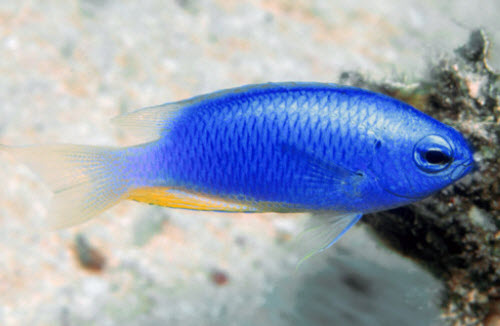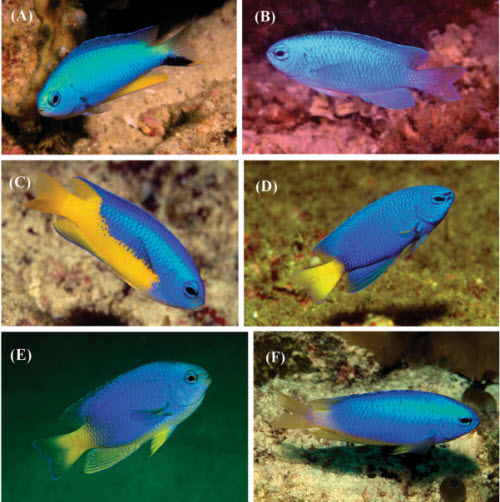
Pomacentrus micronesicus – new damselfish species from Micronesia
Picture above Courtesy of Jeanette Johnson. Liu et al. Zoological Studies 2013 52:6 doi:10.1186/1810-522X-52-6
Say hello to Pomacentrus micronesicus, a newly described species of blue damselfish! It has been given the name Pomacentrus micronesicus since is was found in Micronesia.
The new species was identified by Shang-Yin Vanson Liu (National Taiwan University), Hsuan-Ching Hans Ho (University of California) and Chang-Feng Dai (National Dong Hwa University). The full report “A new species of Pomacentrus (Actinopterygii: Pomacentridae) from Micronesia, with comments on its phylogenetic relationships” has been published by Zoological Studies and can be found here.
Cryptic species
There are plenty of known species of blue damselfish already, and now the Micronesian damselfish Pomacentrus micronesicus has been added to the mix. It looks very similar to several other species of blue damselfish, but the presence of only a light yellow coloration on the ventral fins and tail can help us a bit when it comes to distinguishing the Micronesian damselfish from other similar species of blue damselfish. There are also a few other things to look for, which you will find more information about further down on this page.
Marine organisms that look extremely similar but are actually genetically distinct are known as cryptic species. Thanks to new techniques for DNA sequencing, it has become possible for researchers to test if two similarly looking specimens are genetically distinct or not. This is what Vanson Liu, Hans Ho and Dai did to the fish they collected off the cost of the Marshall Islands, and this is how they were able to confirm that they had encountered a new species of damselfish.
Where does this species live?
The 21 specimens of Pomacentrus micronesicus collected for the study lived around the Marshall Islands in Micronesia, in the western Pacific Ocean.
The holotype was found near the Kwajalein Atoll (9°11′2.87″N, 167°25′4.88″E), at a dept of 5-10 meters. It was hand netted by Scott Johnson on August 2, 2009.
What does a Micronesian damselfish like?
No specimens longer than 30 mm has been found so far. Pomacentrus micronesicus is metallic blue both anteriorly and dorsally, with a light yellow ventral portion. The dorsal fin has the same metallic blue color, while the pectoral fin (including the soft ray of the pectoral fin) is of a light blue shade. The pelvic fin is light blue to yellow, with a blue anterior margin. The anal fin is also light blue to yellow, and has a blue margin, but is in addition to this adorned with small blue spots. The caudal fin is light blue to yellowish, with a few blue spots on the anterior portion.
Pomacentrus micronesicus has a deeply forked caudal fin with a relatively long filamentous upper lobe. The body is ovate and slightly elongated. The mouth is terminal, small and oblique and forms an angle of about 40° to 60° to the horizontal axis of the head and body.
How can I distinguish between Pomacentrus micronesicus and Pomacentrus colestis?

Photographs of the P. coelestis complex. (A) P. alleni, Weh Island, Sumatra, Indonesia. (B)P. coelestis, Nusa Kode, Komodo Islands, Indonesia. (C)P. auriventris, Raja Ampat Islands, Indonesia. (D)P. similis, Mergui Archipelago, Myanmar. (E)P. caeruleus, Andavadoaka, southwestern Madagascar. (F)P. micronesicus sp. nov., Chuuk, Federated States of Micronesia. Courtesy of GR Allen.
Liu et al. Zoological Studies 2013 52:6 doi:10.1186/1810-522X-52-6
P. micronesicus and P. colestis looks very similar to each other, but there are a few differences that can be useful for the reef aquarium keeper.
- Pomacentrus micronesicus tend to have a lower body depth than Pomacentrus colestis.
- Pomacentrus micronesicus usually has 15 rays on the anal fin while Pomacentrus colestis usually has just 14 rays.
- Pomacentrus micronesicus has 15 or 16 rakers on the lower limb of the first gill arch. Pomacentrus colestis has 13-14 rakers.
- Pomacentrus micronesicus has a total of 20-23 gill rakers on the first gill arch. Pomacentrus colestis only has 18-21 rakers.
- Look at the caudal fin of your fish. Pomacentrus micronesicus usually has a filamentous upper lobe that is deeply concave. Although this can occur in Pomacentrus colestis too, it is much less common.